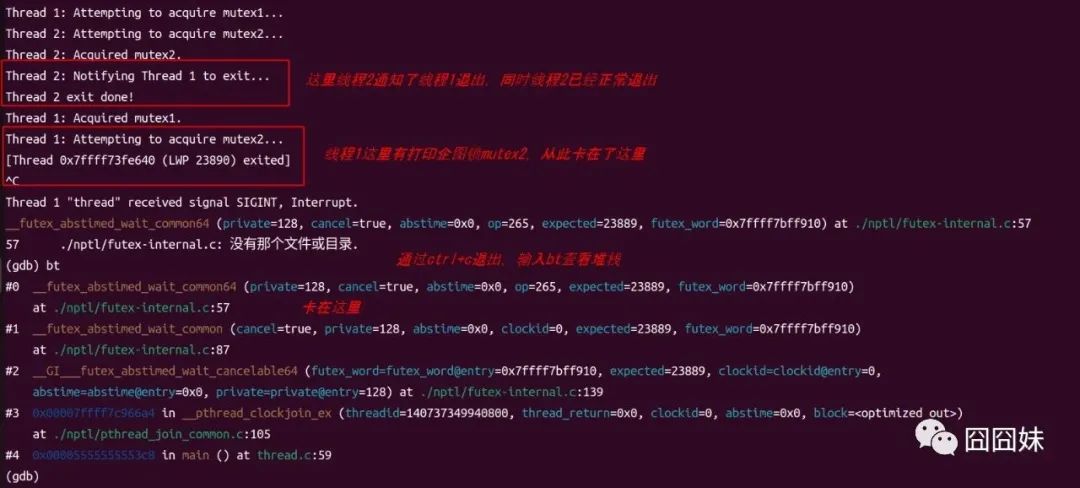解鎖多線(xiàn)程死鎖之謎:深入探討使用GDB調(diào)試的技巧
多線(xiàn)程編程是現(xiàn)代軟件開(kāi)發(fā)中的一項(xiàng)重要技術(shù),但隨之而來(lái)的挑戰(zhàn)之一是多線(xiàn)程死鎖。多線(xiàn)程死鎖是程序中的一種常見(jiàn)問(wèn)題,它會(huì)導(dǎo)致線(xiàn)程相互等待,陷入無(wú)法繼續(xù)執(zhí)行的狀態(tài)。這里,我們將探討多線(xiàn)程死鎖的概念、原理,同時(shí)我們通過(guò)一個(gè)例子來(lái)介紹如何使用GDB(GNU Debugger)這一工具來(lái)排查和解決多線(xiàn)程死鎖問(wèn)題。

多線(xiàn)程死鎖的概念
多線(xiàn)程死鎖是多線(xiàn)程編程中的一種關(guān)鍵問(wèn)題。它發(fā)生在多個(gè)線(xiàn)程試圖獲取一組資源(通常是鎖或資源對(duì)象)時(shí),導(dǎo)致彼此相互等待的情況。具體來(lái)說(shuō),當(dāng)線(xiàn)程1持有資源A并等待資源B,而線(xiàn)程2持有資源B并等待資源A時(shí),就可能發(fā)生死鎖。
多線(xiàn)程死鎖原理
為了更好地理解多線(xiàn)程死鎖的原理,讓我們考慮一個(gè)簡(jiǎn)單的示例。假設(shè)有兩個(gè)資源A和B,以及兩個(gè)線(xiàn)程(Thread 1和Thread 2)。線(xiàn)程1需要獲取資源A和B,線(xiàn)程2需要獲取資源B和A。如果線(xiàn)程1獲取了資源A,而線(xiàn)程2獲取了資源B,它們都無(wú)法繼續(xù),因?yàn)樗鼈兌夹枰獙?duì)方持有的資源才能繼續(xù)。這就是典型的死鎖情況。
多線(xiàn)程死鎖通常發(fā)生在以下情況下:
- 線(xiàn)程同時(shí)持有一個(gè)資源并等待另一個(gè)資源。
- 資源分配不當(dāng),線(xiàn)程沒(méi)有按照相同的順序獲取資源。
多線(xiàn)程死鎖之所以會(huì)發(fā)生,是因?yàn)榫€(xiàn)程之間的相互依賴(lài)和等待。當(dāng)多個(gè)線(xiàn)程需要共享資源時(shí),它們可能會(huì)按不同的順序獲取這些資源,導(dǎo)致資源互斥問(wèn)題,最終引發(fā)死鎖。
排查多線(xiàn)程死鎖
GDB是一個(gè)強(qiáng)大的調(diào)試工具,可以用來(lái)排查多線(xiàn)程死鎖問(wèn)題。下面通過(guò)一個(gè)例子來(lái)說(shuō)下如何使用gdb調(diào)試死鎖問(wèn)題,這也是前段時(shí)間我碰鎖問(wèn)題新學(xué)到的技能。
簡(jiǎn)單的代碼如下:
#include <stdio.h>
#include <pthread.h>
#include <stdlib.h>
#include <unistd.h>
#include <time.h>
pthread_mutex_t mutex1 = PTHREAD_MUTEX_INITIALIZER;
pthread_mutex_t mutex2 = PTHREAD_MUTEX_INITIALIZER;
pthread_cond_t exit_condition = PTHREAD_COND_INITIALIZER;
int should_exit = 0;
void *thread1_function(void *arg) {
while (1) {
printf("Thread 1: Attempting to acquire mutex1...\n");
pthread_mutex_lock(&mutex1);
printf("Thread 1: Acquired mutex1.\n");
printf("Thread 1: Attempting to acquire mutex2...\n");
pthread_mutex_lock(&mutex2);
printf("Thread 1: Acquired mutex2.\n");
// 在此處檢查是否應(yīng)該退出
if (should_exit) {
pthread_mutex_unlock(&mutex2);
pthread_mutex_unlock(&mutex1);
break;
}
pthread_mutex_unlock(&mutex1);
pthread_mutex_unlock(&mutex2);
}
printf("Thread 1 exit done!\n");
pthread_exit(NULL);
}
void *thread2_function(void *arg) {
sleep(5); // 讓線(xiàn)程2休眠10秒鐘
printf("Thread 2: Attempting to acquire mutex2...\n");
pthread_mutex_lock(&mutex2);
printf("Thread 2: Acquired mutex2.\n");
printf("Thread 2: Notifying Thread 1 to exit...\n");
should_exit = 1;
pthread_cond_signal(&exit_condition);
//通過(guò)不釋放該鎖制造死鎖
pthread_mutex_unlock(&mutex2);
printf("Thread 2 exit done!\n");
//exit執(zhí)行后不會(huì)再執(zhí)行該函數(shù)后面部分
pthread_exit(NULL);
}
int main() {
pthread_t thread1, thread2;
pthread_create(&thread1, NULL, thread1_function, NULL);
pthread_create(&thread2, NULL, thread2_function, NULL);
pthread_join(thread1, NULL);
pthread_join(thread2, NULL);
return 0;
}代碼很簡(jiǎn)單,通過(guò)創(chuàng)建兩個(gè)線(xiàn)程,線(xiàn)程1睡眠5s為mutex2加鎖并通知線(xiàn)程1進(jìn)行退出,之后線(xiàn)程2退出,線(xiàn)程1是個(gè)while循環(huán),不停的對(duì)mutex1進(jìn)行加解鎖,并加鎖后檢測(cè)是否退出,退出則對(duì)mutex2進(jìn)行加鎖打印,然后釋放mutex1、mutex2進(jìn)行退出。
使用:gcc thread.c -g -lpthread -o thread編譯,因?yàn)橐猤db調(diào)試所以需要帶上-g參數(shù),正常現(xiàn)象會(huì)執(zhí)行結(jié)束打印如下:

現(xiàn)在我們屏蔽掉線(xiàn)程2釋放mutex2進(jìn)行死鎖調(diào)試:
void *thread2_function(void *arg) {
sleep(5); // 讓線(xiàn)程2休眠10秒鐘
printf("Thread 2: Attempting to acquire mutex2...\n");
pthread_mutex_lock(&mutex2);
printf("Thread 2: Acquired mutex2.\n");
printf("Thread 2: Notifying Thread 1 to exit...\n");
should_exit = 1;
pthread_cond_signal(&exit_condition);
//通過(guò)不釋放該鎖制造死鎖
//pthread_mutex_unlock(&mutex2);
printf("Thread 2 exit done!\n");
//exit執(zhí)行后不會(huì)再執(zhí)行該函數(shù)后面部分
pthread_exit(NULL);
}實(shí)際環(huán)境中我們并不知道死鎖發(fā)生,所以我們通過(guò)gdb先運(yùn)行一次直到程序無(wú)法正常退出時(shí),執(zhí)行bt查看堆棧:

這里因?yàn)榧恿舜蛴∷院芸炜梢钥吹絤utex2上鎖那里卡住,實(shí)際環(huán)境會(huì)有很多線(xiàn)程運(yùn)行,我們并不直到哪里會(huì)有問(wèn)題,此時(shí)只能通過(guò)bt查看堆棧我們發(fā)現(xiàn)卡在函數(shù)__futex_abstimed_wait_common64,運(yùn)行到./nptl/futex-internal.c文件第57行。
這里我們只需要知道該函數(shù)__futex_abstimed_wait_common64是Linux內(nèi)核中用于處理互斥鎖等待超時(shí)的一個(gè)內(nèi)部函數(shù)即可。
此時(shí)可以斷定代碼存在死鎖問(wèn)題了,我們繼續(xù)排查。
我們繼續(xù)看bt信息,發(fā)現(xiàn)該等待是從#4 0x00005555555553c8 in main () at thread.c:59調(diào)入的,因?yàn)榍懊媸?4,所以使用f 4進(jìn)入該函數(shù)。

我們發(fā)現(xiàn)是main里調(diào)入,同時(shí)在執(zhí)行thread1的pthread_join,所以前面的__futex_abstimed_wait_common64并不是我們真正要找的問(wèn)題,其實(shí)thread1已經(jīng)來(lái)到了join的位置,等待結(jié)束了。我們繼續(xù)執(zhí)行thread apply all bt把所有線(xiàn)程堆棧打出來(lái)看下:

根據(jù)前面分析thread 1已經(jīng)正常退出了,我們這里看到thread 2卡在futex_wait,根據(jù)上下文非常明顯是在等待futex lock,再往下看我們發(fā)現(xiàn)鎖mutex2,這里就是thread2在等待mutex2,那么mutex2被誰(shuí)lock住沒(méi)釋放呢?我們通過(guò)p mutex2來(lái)查看owner即可知道該鎖被誰(shuí)擁有。

這里有個(gè)問(wèn)題,是因?yàn)樵摯a恰巧thread 1退出等待join了,所以這里的23890是個(gè)內(nèi)核線(xiàn)程,在持有著mutex2,實(shí)際環(huán)境中我們會(huì)看到owner大概會(huì)是info threads中的LWP,于是就可以定位到該鎖被誰(shuí)持有沒(méi)有釋放了,再分析代碼即可。
我把thread 1再改下,不直接退出而是一直while(1)的形態(tài)來(lái)測(cè)試,此時(shí)再通過(guò)上述來(lái)查找mutex2被誰(shuí)持有即可直觀看到:




























